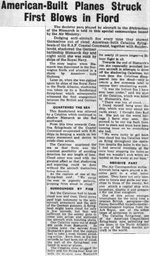
Article from the
News Chronicle No. 29,658
of May 28, 1941, page 1. |
The story begins when Bismarck was discovered in the Norwegian fiords and attacked in a storm by American - built Hudsons.
Later on, when she was sighted again by ships of the Royal Navy in the North Atlantic, shadowing was taken up by a Sunderland lying-boat which subsequently witnessed the first engagement between the British and German forces.
QUARTERED THE SEA
This Sunderland was relieved by a Catalina which continued to shadow Bismarck as she fled southward.
From this time onwards Catalina flying-boats of the Coastal Command co-operated with H.M. ships in keeping a watch on her every movement and device to evade close action.
The Catalinas quartered the sea so that there was the scantiest possibility of avoiding detection for ny length of time.
Cloud cover was used with the greatest effect so that shadowing and reporting could be done without the aircraft themselves being detected.
As the captain of one of the flying-boat said: "We swept the seas in gigantic patterns, hopping from cloud to cloud."
SURROUNDED BY FIRE
But the Catalinas had to break cloud now and then.
Their crews paid high testimony to the antiaircraft armament and the skill of the German gunners.
A flying boat might leave cloud for only a few seconds, but that was sufficient for the enemy guns to come into action and surround the aircraft with bursting shells.
One Catalina came out of cloud 400 yards from Bismarck.
So intense were the salvoes from Bismarck's guns that the captain had to take a most violent avoiding action.
Even then, in the few seconds he had been out of cloud, the hull of the flying-boat was holed in several places.
The Catalina crew plugged the holes and the flying-boat kept on with its mission over Bismarck for nearly 10 hours longer - a 20 hour flight in all.
Towards the end of Bismarck's run she repeatedly launched her own aircraft in attempts to drive off the shadowing Catalinas, but each time the Catalinas disappeared into the cloud - only to return a few moments later to resume their unrelenting watch.
"It was the hottest fire I have ever been under," said the pilot of the Catalina, which was holed by Bismarck's fire.
"There was lots of cloud. . . . I found myself bang over the ship, which was only about 400 yards away.
I thought they had us.
She put up the worst barrage I have ever seen.
She seemed to be on big flash from bow to stern and must have been turning loose on us everything she had.
"We were lucky to get back into the cloud but the Catalina went on flying throughout the operation despite the holes in the hull.
I had several members of the crew busy stopping the holes so that we wouldn't sink when we landed on the water at our base."
DECISIVE PART
The Air Correspondent writes: Aircraft have again played a decisive part in a vital naval action.
They have not only been able to locate and guide our warships to those of the enemy, but also attack a capital ship with torpedoes, disable it and prepare it for the final slaughter.
Out of this action emerges triumphant for the third time a veteran British aeroplane - the Fairey Swordfish torpedo-spotter reconnaissance biplane from the Ark Royal, one of the oldest types of aeroplane in service.
The Catalina flying-boat, one of the American Consolidated flying-boats now patrolling our sea lanes in the North Atlantic, is one of the finest marine aircraft in the world.
|


